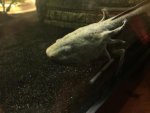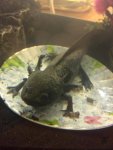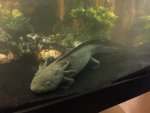Jinxei
New member
Hey,
You might have seen me post about three weeks ago. I had rescued an older axolotl from a local pet store. She was in extremely poor conditions and had a bad fugal infection. After about a week and a half of salt and tea baths, she started to physically look a lot better.
Well, starting around mid-week 2, she started to act extremely lethargic. Now I understand that axolotl aren't very active, but she will sit in her cave 24-48 hours without moving. She also has yet to eat, and the pet store was unreliable in knowing when she last ate either. I've tried bloodworms, earthworms, brine shrimp, pellets. I rinse them, tried garlic powder, tried different methods of feeding her and nothing seems to work.
Unfortunately, I'm unsure what to do at this point. I was extremely hopeful about her getting better but that is all starting to fade. Water parameters are perfect, I test twice a day. She came in with another axolotl, do they get depressed? I've read that they aren't social creatures, but I have also read a lot of people that think that's not true and that they ARE social.
You might have seen me post about three weeks ago. I had rescued an older axolotl from a local pet store. She was in extremely poor conditions and had a bad fugal infection. After about a week and a half of salt and tea baths, she started to physically look a lot better.
Well, starting around mid-week 2, she started to act extremely lethargic. Now I understand that axolotl aren't very active, but she will sit in her cave 24-48 hours without moving. She also has yet to eat, and the pet store was unreliable in knowing when she last ate either. I've tried bloodworms, earthworms, brine shrimp, pellets. I rinse them, tried garlic powder, tried different methods of feeding her and nothing seems to work.
Unfortunately, I'm unsure what to do at this point. I was extremely hopeful about her getting better but that is all starting to fade. Water parameters are perfect, I test twice a day. She came in with another axolotl, do they get depressed? I've read that they aren't social creatures, but I have also read a lot of people that think that's not true and that they ARE social.






